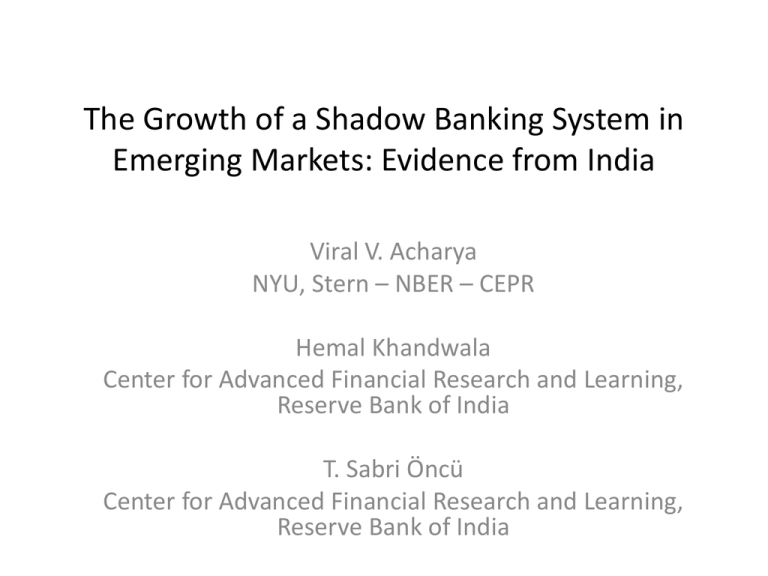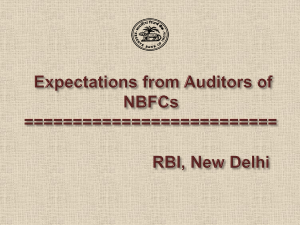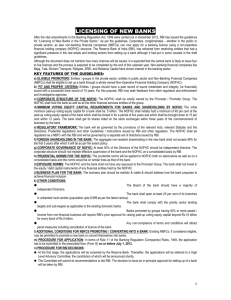The Growth of a Shadow Banking System in Emerging Markets
advertisement

The Growth of a Shadow Banking System in Emerging Markets: Evidence from India Viral V. Acharya NYU, Stern – NBER – CEPR Hemal Khandwala Center for Advanced Financial Research and Learning, Reserve Bank of India T. Sabri Öncü Center for Advanced Financial Research and Learning, Reserve Bank of India Objective of the Study Our goal is to investigate the rapid growth of the non-deposit taking nonbank finance corporations (NBFCs) in India to understand - Incentives underlying the formation of shadow banking institutions, if any. - Linkages between banking sector and NBFCs. - How the nature of the banking sector (state-owned versus private banks) affects the growth and constraints on NBFCs. 2 Summary of Results • Bank lending to the non-deposit taking NBFCs – forms a significant proportion of these NBFC’s liabilities. – fluctuates in line with bank allocation to priority lending sectors. – appears to be greater for banks that have lower branching in semiurban areas relative to metropolitan areas. • However, bank lending to these NBFCs is virtually non-existent for the largest state-owned bank, State Bank of India (SBI), and its affiliates, which have strong semi-urban branching. • These bank-NBFC linkages are present for those NBFCs that do loans or asset financing and not for investment companies, and also affect the credit growth of these NBFCs. • Starting with the financial crisis of Fall 2008, bank lending to these NBFCs experienced a permanent contraction that is related to the shift of term deposits towards SBI Group. 3 What is Shadow Banking? Shadow Banking is an evolving concept. Many non-intersecting but non-contradictory definitions. However, below are the key points emerged so far: Maturity, credit and liquidity transformation outside the traditional banking system; Less regulated than the traditional banking system or not regulated at all; No explicit access to central bank liquidity or public sector credit guarantees; 4 What is Shadow Banking? Highly levered; Assets are risky and illiquid; Liabilities are prone to “bank runs”; Decomposes the process of credit intermediation into a sequence of discrete operations. Therefore, it can be a collection not only of single financial entities acting independently, but also of (and usually is) networks of multiple financial entities acting together or both: banks, formal and informal nonbank financial institutions, and even credit rating agencies, regulators and governments. 5 Commercial Banks Public Banks Private Banks State Bank of India and Associate Banks (6) Old Private Banks (14) Nationalized Banks (20) New Private Banks (7) Foreign Banks (36) Regional Rural Banks (82) 6 Bank Groups by Assets (Trillions of rupees) 7 Reserve Bank of India Regulated NBFCs Loosely Regulated/Monitored Tightly Regulated/Monitored Deposit taking NBFC-D Asset Finance Company Loan Company Investment Company Residual NBFCs Non-deposit Taking – Systemically Important NBFC-ND-SI All other NBFCs including Microfinance Institutions Asset Finance Company Loan Company Investment Company Core Investment Company Infrastructure Finance Company 8 Classification of NBFCs Activity Based Asset Finance Company is a company: carrying on as its principal business the financing physical assets supporting productive/economic activity: autos, tractors, material handling equipments, etc. Loan Company is a company: carrying on as its principal business the providing of finance whether by making loans or advances or otherwise for any activity other than its own. Investment Company is a company: carrying on as its principal business the acquisition of securities. Core Investment Company is an investment company whose: 90% of Net Assets in equity shares, preferred shares, bonds or loans of a group of companies or 60% of Net Assets in equity shares of a group of companies. Infrastructure Finance Company is a company which: deploys at least 75 per cent of its total assets in infrastructure loans. 9 Classification of NBFCs Organization Based Standalone NBFCs; Bank and Financial Institution Sponsored NBFCs: according to the RBI, there are 28 currently: 18 sponsored by foreign banks and financial institutions; 10 sponsored by Indian banks. Captive NBFCs: set up to put the parent company's products within the reach of consumers and to ensure that the company has a steady pool of buyers; any major challenges confronting the parent could threaten the operations and asset values of the captive NBFC. Multiple NBFCs: companies which have multiple NBFCs within their group; example: Shriram Group; their argument is that operational efficiencies arising out of specialization, dynastic reasons, tax planning are some of the reasons for multiple NBFCs. 10 From Deposit-taking to Non-deposit NBFCs Since RBI introduced prudential norms in 1998, the number and share of deposit-taking NBFCs has been shrinking The RBI introduction of non-deposit taking systemically important (SI) NBFCs in 2006 has been coincident with significant growth in this newer class of NBFCs As a combination of these two effects, the NBFC share of deposits has been shrinking steadily 11 Comparison between NBFC and Bank Sectors Trillions of Rupees FY06 FY10 FY11 Number of NBFCs 13,014 12,630 12,409 Bank Credit of all Scheduled Banks 15.728 33.377 40.608 NBFC Credit as percentage of Bank Credit 10.77% 12.57% 13.20% Assets of all Scheduled Banks 25.315 52.58 61.47 NBFC Assets as percentage of Bank Assets 13.06% 13.33% 13.78% Bank Deposits of all Scheduled Banks 21.858 46.352 53.552 NBFC Public Deposits as percentage of Bank Deposits 1.05% 0.37% 0.22% NBFCs include NBFC-D, NBFC-ND-SI and RNBCs Scheduled Banks include Commercial Banks and Cooperative Banks 12 Growth of the NBFC Sector 800 16000 NBFC-D NBFC-ND-SI 700 14000 600 12000 400 6000 300 4000 200 2000 100 0 0 1999 2000 2001 2002 2003 2004 2005 2006 2007 2008 2009 2010 2011 8000 Number of All NBFCs 1999 2000 2001 2002 2003 2004 2005 2006 2007 2008 2009 2010 2011 500 10000 Number of NBFC-Ds and NBFC-ND-SIs 13 Growth of the NBFC Sector NBFC-D 7.0 12.0 NBFC-ND-SI NBFC-D NBFC-ND-SI 10.0 6.0 5.0 8.0 4.0 6.0 3.0 4.0 2.0 2.0 1.0 0.0 0.0 2006 2007 2008 2009 2010 Assets in Trillions of Rupees 2011 2006 2007 2008 2009 2010 2011 Assets as percentage of Assets of Banks 14 Consolidated Balance Sheet of NBFCs Trillions of Rupees NBFCs include NBFC-D, NBFC-ND-SI and RNBCs 15 Leverage of the NBFCs: Borrowings/Total Assets Bank & FI loans as large or larger than Debentures (Excluding RNBCs) B&FI Debentures B&FI Total Borrowings 80% 80% 70% 70% 60% 60% 50% 50% 40% 40% 30% 30% 20% 20% 10% 10% 0% 2007 2008 2009 NBFC-D 2010 2011 Debentures Total Borrowings 0% 2007 2008 2009 2010 NBFC-ND-SI 2011 16 Given this motivation, the questions we ask are: 1. What role does lending to NBFCs play for banks? - Given the semi-urban focus of NBFCs, is it related to bank lending to priority sector and their ability to reach out semi-urban areas? Which type of banks (state, private, foreign) lend to NBFCs? 2. What affects the ability of banks to lend to NBFCs? - Is it affected by stability of bank deposits? In turn, does bank lending affect NBFC credit growth? 3. How did the deposit shift in the crisis of 2008 affect NBFCs? - In particular, did the shift to banks with stronger guarantees (SBI group) constrain the NBFC growth? 17 We use coarser NBFC and Bank Group types 1. NBFC types: • Investment Companies (borrow little from Banks and serve as “placebo”); • Finance Companies (larger in assets, borrow more from Banks & FI). 2. Bank group types: • • • • • The SBI Group; Nationalized Banks; New Private Banks; Old Private Banks; Foreign Banks. Other Bank Groups 18 Credit Growth of Investment vs Finance NBFCs 19 Bank & FI loans to Investment vs Finance NBFCs 20 Five datasets (June qtr 2006 – June qtr 2011) • NBFC-level balance sheet and non-performing asset data on systemically important non-deposit taking NBFCs • Bank group-level balance sheet data on bank groups • Bank group-level priority sector lending data on bank groups • Bank group-level bank branch data on bank groups • Economic data on Indian 3 month and 10 year yields, gross domestic product and wholesale price index. • Sample inclusion criteria yield an imbalanced panel data set of 257 NBFCs and 2374 NBFC-quarters from an initial imbalanced panel data set of 383 NBFCs and 3629 NBFC-quarters 21 22 23 Table II Result Ia: Bank Loans to NBFCs positively related to Bank Priority Sector Lending, except for SBI Group Result Ib: NBFC Credit Growth is lower when Bank Priority Sector Lending is higher (substitution) 24 25 Table III Result IIa: Bank Loans to NBFCs negatively related to Semi-urban to Metropolitan branching, except for SBI Group Result IIb: NBFC Credit Growth is lower when Bank Semi-urban to Metropolitan branching is higher 26 27 Branching (Semi-urban to metropolitan) by Bank Group 28 Bank-NBFC Transmission in the Crisis of Fall 2008 • A “shadow bank run” on the NBFCs, resulting from a “run” on 1. 2. The private sector banks (transmitted to the NBFCs through bank loans) The mutual funds (transmitted to the NBFCs through commercial paper). • RBI Deputy Governor Usha Thorat described the situation as follows: “Especially the public sector bank deposits went up and the private sector bank deposits took a knock. So, the private sector banks were quite resource constrained. Also, the RBI facilities were mostly collateralized ones against government securities and private sector banks did not have sufficient securities above the statutory requirements to be able to take RBI liquidity – which meant they were constrained on liquidity at the same time that lending by banks to NBFCs decelerated. 29 Bank-NBFC Transmission in the Crisis of Fall 2008 • RBI Deputy Governor Usha Thorat described the situation for NBFCs as: “In Aug 2008, some NBFCs faced a liquidity problem. Many of them were even doubtful whether their CPs would be rolled over. Some of them had to have liquidity infusion from their sponsors. Bank credit lines started choking. The mutual funds, which had invested in the NBFCs’ short term paper, withdrew or started selling these. In fact, the vulnerability of this sector to liquidity risk got exposed. There was huge pressure on the RBI to open a liquidity window special for NBFCs. The RBI Act prohibits lending to non-banks (except for some very few categories) and so we did open a window through banks. But banks were quite reluctant to use it as they had to take credit risk of NBFCs, which they started getting very wary about. When banks were unwilling to finance NBFCs, the RBI opened a special facility through a structured vehicle, which was already located in the IDBI.” 30 Term Deposit Flight from Private to Public Banks 31 Bank Credit skewed towards SBI Group 32 Priority Sector Lending also skewed to SBI Group 33 Credit Growth of Investment vs Finance NBFCs 34 Bank & FI loans to Investment vs Finance NBFCs 35 Table VII Result IIIa: Bank Loans to NBFCs negatively related to the Crisis (permanent effect) and the Term to Total Deposits for the SBI Group Result IIIb: NBFC Credit Growth is lower since the Crisis (permanent effect) and the Term to Total Deposits for non-SBI Group is higher (substitution) 36 37 Summary of Results • Bank lending to the non-deposit taking NBFCs – forms a significant proportion of these NBFC’s liabilities. – fluctuates in line with bank allocation to priority lending sectors. – appears to be greater for banks that have lower branching in semiurban areas relative to metropolitan areas. • However, bank lending to these NBFCs is virtually non-existent for the largest state-owned bank, State Bank of India (SBI), and its affiliates, which have strong semi-urban branching. • These bank-NBFC linkages are present for those NBFCs that do loans or asset financing and not for investment companies, and also affect the credit growth of these NBFCs. • Starting with the financial crisis of Fall 2008, bank lending to these NBFCs experienced a permanent contraction that is related to the shift of term deposits towards SBI Group. 38 Conclusions • The non-deposit taking NBFCs in India likely represent a completeness of credit allocation in non-metropolitan areas of the Indian economy by banks with less than fully-developed branching networks. • This NBFC role has been potentially constrained by distortions in bank deposit base arising from a lack of level-playing field in the perceived government support of different banking groups. • Since these NBFCs are relatively well-regulated on the capital front, it is primarily their linkage to the banking sector that stands out as a potential concern for systemic risk considerations. • Furthermore, our results highlight that shadow banking in emerging markets may look quite different from that in developed economies. 39





